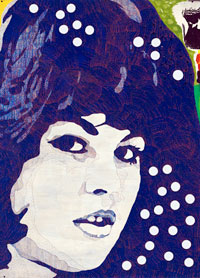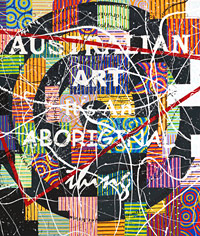Previous exhibitions 2008
Current and future | Travelling | Previous
Previous 2008 | 2007 | 2006 | 2005 | 2004 | 2003 | 2002 | 2001 | 2000 | 1999 | 1998 | Previous children's
![Andre Roosevelt 'Legong dancer, Bali [Ni Pollok, aged about 11, later the model and wife of Belgian painter in Bali, A J. Le Mayeur]' 1928 gelatin silver photograph Collection of the National Gallery of Australia](/web/20081112190407im_/http://www.nga.gov.au/exhibitions/Images/171989.jpg) Picture Paradise
Picture Paradise
Asia-Pacific photography 1840s -1940s
11 July – 28 September 2008
Picture Paradise is the first ever comparative survey exhibition of the history of photography in the Asia–Pacific region, from the formative decades of the 1840s to 1860s to the early 1940s and the advent of the Second World War.
The exhibition chronicles the developments in photography throughout South and Southeast Asia, Australia and the Pacific to the west coast of North America. Early photography in the Asia–Pacific region reveals the beauty and cultural diversity of the region.
Picture Paradise is presented in conjunction with Vivid, Australia’s inaugural National Photography Festival, celebrating photography’s vital role in Australian life and history.
Proudly supported by the National Gallery of Australia Council Exhibitions Fund
This exhibition is part of Vivid Australia's first ever National Photography Festival. Find out more about at nla.gov.au/vivid
Andre Roosevelt Legong dancer, Bali 1928 gelatin silver photograph
National Gallery of Australia, Canberra
 Richard Larter
Richard Larter
a retrospective
20 June – 14 September 2008
Richard Larter is widely considered to be one of Australia’s most distinguished artists. Born in 1929 he arrived in Australia from England in 1962 and, over the ensuing four decades, created an impressive, provocative, lively body of work.
Larter’s lively wit and satirical insights are matched by his considerable abilities as a draughtsman and particularly as a great colourist. His ability to combine politics, history and sexuality mixed with feeling for colour makes his works unique, energetic and challenging.
Richard Larter Sliding Easy 1970 (detail) synthetic polymer paint on hardboard
National Gallery of Australia, Canberra
12 April – 30 August 2008 | Children's Gallery
An exhibition designed especially for children 3-8 years old in conjunction with Turner to Monet: the triumph of landscape.
Discover art works which are made from trees, are about trees or even things that live in trees. Treescape’s aim is to stimulate an appreciation of trees as a subject for interesting and exciting artworks.
See paintings, photographs, drawings, prints, sculpture, installations, furniture and more.
Children can trace a tree to take home and have fun with a magnetic tree.
Patrick Collins Curtain call 2003 (detail) ceramic, earthenware, tin-glazed
National Gallery of Australia, Canberra
![Monet 'Meules, milieu du jour [Haystacks, midday] [also known as Meules au soleil, milieu du jour and Grainstacks, midday]' 1890 Painting, oil on canvas Collection of the National Gallery of Australia](/web/20081112190407im_/http://www.nga.gov.au/exhibitions/Images/29073.jpg) Turner to Monet
Turner to Monet
The triumph of landscape
Turner to Monet presents an opportunity to experience paintings never before seen in Australia, and only at the National Gallery of Australia.
Works by the finest artists of the time – Turner, Constable, Friedrich, Corot, Courbet, Glover, von Guérard, Church, Streeton, Roberts, Cézanne, Van Gogh, Gauguin, Monet – have been gathered from public and private collections from around the world.
The exhibition provides a unique opportunity for Australians to see landscape masterpieces in oil and watercolour from the finest collections of the world, including Tate Britain, Royal Academy of Arts, J Paul Getty Museum, National Gallery of Art, Washington, and Kröller-Müller Museum.
Claude Monet 'Meules, milieu du jour [Haystacks, midday] [also known as Meules au soleil, milieu du jour and Grainstacks, midday]' 1890 (detail) oil on canvas Collection of the National Gallery of Australia
![Monet 'Meules, milieu du jour [Haystacks, midday] [also known as Meules au soleil, milieu du jour and Grainstacks, midday]' 1890 Painting, oil on canvas Collection of the National Gallery of Australia](http://web.archive.org/web/20081112190407im_/http://nga.gov.au/artonline/96/167030.jpg) Australian Surrealism
Australian Surrealism
The Agapitos Wilson collection
16 February – 11 May 2008
Surrealism, the great revolutionary movement originating in France in the 1920s, was to change the course of Australian art in the 1940s. A generation of Australian artists including James Gleeson, Sidney Nolan, Albert Tucker, Arthur Boyd and Max Dupain encountered Surrealism at a formative time in their careers, and its influence transformed their art forever.
Drawn from the recently acquired James Agapitos OAM, and Ray Wilson OAM, collection of Australian Surrealist art, this exhibition shows the extraordinary breadth of Surrealist practice in this country from the 1920s to the 1950s.
nga.gov.au/AustralianSurrealism
Clifford Bayliss Man wearing a bowler hat 1945 brush and coloured ink and wash on white wove paper Purchased with the assistance of James Agapitos OAM and Ray Wilson OAM 2007 © Mrs Josephine Bayliss; courtesy Bridget McDonnell Gallery
14 July 2007 – 30 March 2008
Children's Gallery
By looking closely at drawings we can get a powerful insight into the thoughts, ideas and processes that artists explore in their works.
Beginning with the drawings of George Lambert, Drawn in explores some of the ways in which artists use drawing. George Lambert was a master draughtsman, who captured the changing world around him through his pencil impressions and explored new artistic ideas. This exhibition aims to show the way drawing can make thinking visible.
John Brack 'Study for the painting and the lithograph 'Junior Latin American' [Sketch for 'Junior Latin American']' 1969 conte crayon, pencil image Collection of the National Gallery of Australia © Helen Brack
 National Indigenous Art Triennial 07
National Indigenous Art Triennial 07
culture warriors
13 October 2007 – 10 February 2008
The National Gallery of Australia is delighted to present the inaugural National Indigenous Art Triennial. The work of thirty artists has been selected, representing the diversity of regions around Australia and demonstrating the incredible range of contemporary Indigenous art practice. The National Indigenous Art Triennial provides a highly considered snapshot of Aboriginal and Torres Strait Islander contemporary art practice.
Richard Bell Australian Art Its An Aboriginal thing 2006 (detail) synthetic polymer paint on canvas acquired 2006 TarraWarra Museum of Art collection
 Robert Rauschenberg 1967–1978
Robert Rauschenberg 1967–1978
1 September 2007 – 27 January 2008
Robert Rauschenberg moved to New York in 1949, at a time when the avant-garde art scene was dominated by Abstract Expressionism. Right from the beginning, Rauschenberg worked beyond the restrictions imposed by media, style and convention, and adopted a unique experimental methodology that combined gestural mark-making with its antithesis – mechanically reproduced imagery.
His work has been of central influence in many of the significant developments of post-war American art and has provided countless blueprints for artistic innovation by younger generations.
Robert Rauschenberg Horsefeathers Thirteen – I 1972 (detail) planographic, stencil, collage © Robert Rauschenberg
Black robe, white mist
art of the Japanese Buddhist nun Rengetsu
8 September 2007 – 27 January 2008
Otagaki Rengetsu (1791–1875), Lotus Moon, was a Japanese Buddhist nun whose tragic life inspired extraordinary creativity. One of a small number of prominent female artists of 19th-century Japan, Rengetsu was a poet, calligrapher, potter and painter.
Largely drawn from international private collections, Black robe, white mist shows contemplative works of paper and clay inscribed with Rengetsu’s elegant poetry and understated calligraphy. Her work reflects the beauty of the imperfect and unconventional.
Otagaki Rengetsu Fluttering merrily hanging scroll [kakemono] 1840s-50s (detail) calligraphy, painting Private collection, Zurich


![John Brack 'Study for the painting and the lithograph 'Junior Latin American' [Sketch for 'Junior Latin American']' 1969conte crayon, pencil image Collection of the National Gallery of Australia © Helen Brack](/web/20081112190407im_/http://www.nga.gov.au/exhibitions/Images/106321.jpg)
![Otagaki Rengetsu 'Fluttering merrily' hanging scroll [kakemono] 1840s-50s calligraphy, painting Private collection, Zurich](/web/20081112190407im_/http://www.nga.gov.au/exhibitions/Images/16254a.jpg)